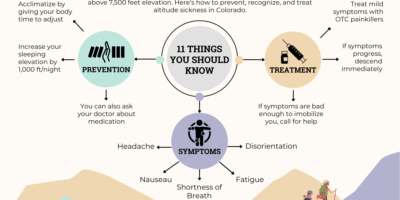Trekking Tips for High-Altitude Hikes
High-altitude trekking presents unique challenges. The thin air can affect your body and mind. Preparation and knowledge are key to a successful and enjoyable trek. Let’s explore some essential tips for high-altitude hikes.
Acclimatization
Acclimatizing to higher altitudes is crucial. Your body needs time to adjust to the lower oxygen levels. Gain elevation gradually. A general rule is to ascend no more than 1,000 feet per day above 8,000 feet. If you ascend more, spend an extra night at that elevation before moving higher.
Hydration
Staying hydrated is essential. Dehydration occurs quicker at high altitudes. Drink plenty of water, even if you don’t feel thirsty. Avoid alcohol and caffeine as they can contribute to dehydration. Consider adding electrolytes to your water to replenish lost minerals.
Nutrition
Your body needs more calories at high altitudes. Eat a balanced diet rich in carbohydrates, proteins, and fats. Carbs are especially important for energy. Carry high-energy snacks like nuts, dried fruits, and energy bars. Avoid heavy, greasy foods that can be tough on digestion.
Pacing
Move at a slow, steady pace. Rapid movement can lead to acute mountain sickness (AMS). Listen to your body. Rest when needed. Allow your body to gradually acclimatize. Shorter, frequent breaks are better than long rests. Maintain a comfortable pace to conserve energy.
Layering
Dressing in layers helps regulate body temperature. Weather at high altitudes can change rapidly. Wear moisture-wicking base layers to keep sweat away from your skin. Add insulating layers like fleece or down. Top it off with a waterproof and windproof outer layer.
Footwear
Choose the right footwear for high-altitude treks. Sturdy, well-fitting boots are essential. Your boots should provide ankle support and have a good grip. Break in new boots before your trip. Use quality socks to prevent blisters. Gaiters can keep debris and snow out of your boots.
Sun Protection
The sun’s rays are stronger at high altitudes. Protect your skin with high-SPF sunscreen. Wear a wide-brimmed hat and UV-blocking sunglasses. Long-sleeve shirts and pants offer additional protection. Apply lip balm with SPF to protect your lips from becoming chapped.
Essential Gear
- Map and compass or a GPS device
- First aid kit
- Multi-tool or knife
- Headlamp with extra batteries
- Emergency shelter
- Biodegradable toilet paper
Environmental Awareness
High-altitude environments are fragile. Practice Leave No Trace principles. Pack out all trash, including food scraps. Stay on designated trails to prevent erosion. Be mindful of wildlife and respect their habitat. Avoid disturbing flora and fauna.
Weather Awareness
Weather can be unpredictable in the mountains. Check the forecast before your trek. Be prepared for sudden changes. Learn to read the sky for signs of approaching storms. If weather conditions worsen, find shelter and stay safe.
Mental Preparation
Mental strength is as important as physical fitness. High-altitude trekking can be mentally challenging. Stay positive and focused. Develop a strategy for dealing with setbacks. Share your goals with your trekking group to maintain motivation.
Emergency Protocols
Know the emergency protocols for your trekking area. Carry a whistle to signal for help. Make sure someone knows your itinerary. Have a plan in place for descending quickly if someone shows signs of severe AMS.
Guides and Porters
Hiring a local guide can enhance your experience. They bring invaluable knowledge of the terrain and culture. Consider hiring porters to carry heavy gear. This allows you to enjoy the trek more and reduces physical strain.
Respect for Local Cultures
High-altitude treks often pass through culturally significant areas. Show respect for local customs and traditions. Learn a few phrases in the local language. Engage with local communities in a respectful manner.
Physical Training
Prepare your body for the demands of high-altitude trekking. Incorporate cardiovascular training, strength training, and flexibility exercises into your routine. Focus on building stamina and endurance. Activities like hiking, running, and cycling can be beneficial.
Travel Insurance
Travel insurance is essential for high-altitude treks. Ensure your policy covers high-altitude hiking and includes evacuation. In case of an emergency, evacuation costs can be substantial. Check the details of your coverage before departure.
Altitude Sickness Awareness
Understand the symptoms of altitude sickness. Early symptoms include headache, nausea, and dizziness. More severe symptoms can include confusion and difficulty breathing. If symptoms worsen, descend immediately. Medication like acetazolamide may help prevent or lessen symptoms.
Communication Devices
Carry a reliable communication device. Satellite phones and personal locator beacons (PLBs) can be lifesavers. Ensure your device is fully charged and knows how to use it. Know the emergency contact numbers in your trekking area.
Permits and Regulations
Check the permit requirements for your trek. Some high-altitude areas have specific regulations. Obtain all necessary permits well in advance. Respect local regulations to preserve the environment and avoid fines.
Trekking Poles
Trekking poles can be extremely helpful. They provide stability and reduce strain on your knees. Adjust the poles to a comfortable height. Use them to maintain balance on uneven terrain. They can also help in crossing streams or snowfields.
Buddy System
Trekking with a partner or group enhances safety. Always stick together, especially at high altitudes. If someone starts feeling unwell, the group can provide support. Communicate openly about how everyone is feeling.
Rest and Recovery
Allow time for rest and recovery. Your body needs to recuperate from exertion. Sleep well and take rest days if necessary. Proper rest helps maintain your energy levels and prevents burnout.
Photography
Capture the beauty of high-altitude landscapes. Carry a camera or a good smartphone. Be mindful of battery life, as it drains faster in cold conditions. Spare batteries or a portable charger can be useful. Enjoy the views, but don’t let photography distract you from safety.
Route Planning
Plan your route thoroughly. Research the terrain, altitude gains, and potential hazards. Have a clear itinerary and share it with someone reliable. Include contingency plans for emergencies or bad weather. Familiarize yourself with the landmarks and trail markers.
“`

